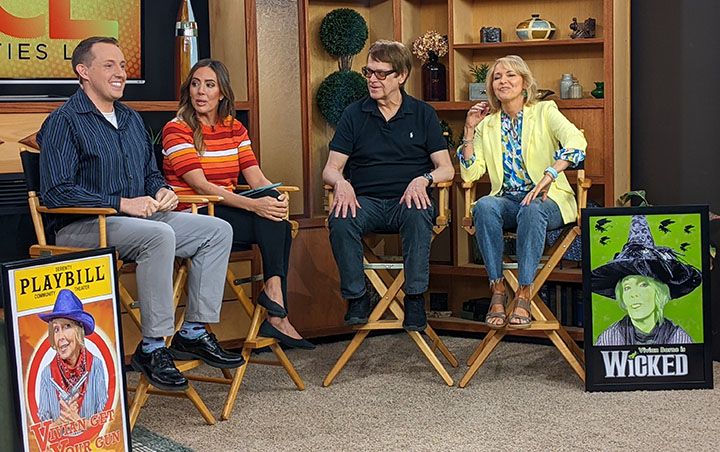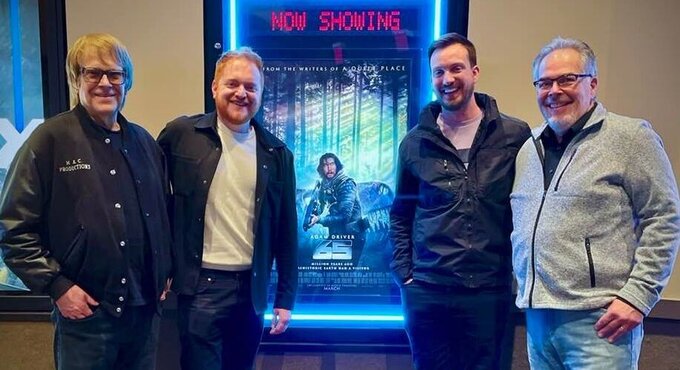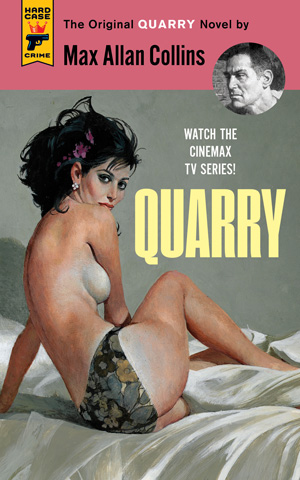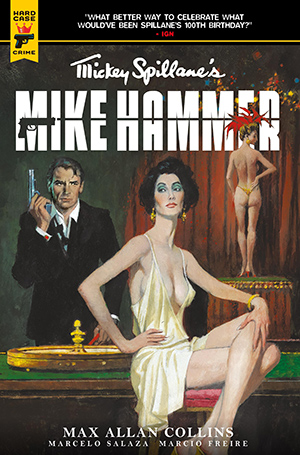We had a terrific Quad Cities premiere for our film Death By Fruitcake, starring Paula Sands, Alisabeth Von Presley and Rob Merritt. It was a packed house at Davenport’s stellar The Last Picture House, the theater that’s the brainchild of our bigtime local filmmakers Scott Beck and Bryan Woods (who brought you A Quiet Place, Heretic and more).
We had a number of cast and crew members on hand, including Paula and Rob, and I led (with producer/d.p./editor) Chad Bishop a Q and A after. I took a spill off the riser onto my back but (with help) got onto my feet to helm the Q and A. Definitely a “show-must-go-on” moment, because I am still (it’s Sunday as I write this) recuperating from my own impromptu stunt-man feat.
Despite this, it was a wonderful evening, thanks to Last Picture House manager Jameson Ritter. Our two Muscatine screenings late last year were marred by sound problems (far too soft, something we weren’t able to rectify on site), but we were nicely loud and pretty impressive on the big screen. For a little movie designed to find a home (or homes) on a streaming service(s), this kind of theatrical exhibition was a rare treat for us (and, I think, the audience).
We promoted the event with an appearance on Quad Cities Live, the afternoon show that followed Paula Sands Live on her retirement from broadcasting. It was fun seeing Paula return to the site of her huge regional success. And what a Vivian Borne she makes! Alisabeth Von Presley, our equally impressive Brandy Borne, couldn’t make it to the event (she was choreographer on a high school production in Cedar Rapids that evening). But what a thrill for Barb and me to see our Barbara Allan/Antiques characters come to such wonderful comic life.

L to R: Kyle Keil (host), Morgan Ottier (host), M.A.C., Paula Sands
Whither Death by Fruitcake? We are talking to various distributors now. I fully expect us to be streaming for this year’s holiday season. Getting on physical media is a trickier proposition as that market has just about vanished except for blockbuster films and the boutique labels, which specialize in horror and cult items, where we don’t fit. That doesn’t mean I won’t try.
If you want to help us in our filmmaking efforts, take a look at Blue Christmas on Tubi right now. Don’t wait for an invitation from Santa.

L to r: Rob Merritt, M.A.C., Tommy Ratkiewicz-Stierwalt

Tommy Ratkiewicz-Stierwalt and Paula Sands

Q and A post-QC premiere at the Last Picture House. L to R: Tracy Peltzer-Timm, Chris Causey, Tommy Ratkiewicz-Stierwalt, Cassidy Ptacek, Rob Merritt, M.A.C., Paula Sands, Chad Bishop

L to R: Paula Sands, Chris Causey, Rob Merritt, Barbara Collins, M.A.C., Chad Bishop

L to r: Tommy Ratkiewicz-Stierwalt, Rob Merritt, Tracy Peltzer-Timm, M.A.C., Lucy Collins, Nathan Collins, Abby Collins, Sam Collins
This link will take you to Paula Sands and me appearing on Quad Cities Live, the show that took the place of her Paula Sands Live, from which she retired after decades of Emmy-winning broadcasting. For longtime fans of my work, you should recall Paula’s wonderful appearance, spoofing herself and her show, in Mommy’s Day (1997).
Here’s an unexpected but welcome review of my 1983 novel, True Detective, which introduced Nathan Heller and my format of weaving a detective story in with actual events/crimes.
It’s interesting to me that a review of a novel I wrote in 1981 and was published in 1983 would appear in 2024 (!).
Two things should be noted, however: the reviewer uses True Detective to recommend the entire series; and it’s appearing just as True Noir: The Assassination of Anton Cermak is getting some nice notice, which may have sparked this review.
True Noir is, as those of you who drop by here regularly know, a ten-episode audio drama with a full cast, sound effects, and score. I consider it the best adaptation of my work done to date (but then why wouldn’t I, having written all ten episodes myself). The cast is incredibly stellar, and our Nathan Heller – Michael Rosenbaum – just effing nails it. The score by Alexander Bornstein is mesmerizingly terrific, and the whole thing has been expertly directed and edited by Robert Meyer Burnett.
You may know Rob from his several YouTube shows (Robservations, Let’s Get Physical Media, regular guest on The John Campea Show), but he is much more than that – an accomplished film director (Free Enterprise), documentarian (Star Trek; The Next Generation), editor (Femme Fatales) and producer (Tango Shalom, aka Forbidden Tango).
All ten episodes of True Noir: The Assassination of Anton Cermak are available at truenoir.co, $29.95 for the complete audio drama – four-and-a-half-hours worth. If you are a member of the Nathan Heller Fan Club (well, there isn’t one, but you know what I mean), you will lose your non-membership in good standing if you haven’t ordered yet.
And I would welcome comments/reviews here from those of you who have enjoyed it thus far.
We will be available on other platforms eventually, but for now it’s truenoir.co. And there’s stuff to look at there, including links to episodes of my History Behind the Mystery video series (directed by my longtime collaborator, Phil Dingeldein) that looks at the real events depicted in each episode.
M.A.C.








